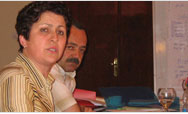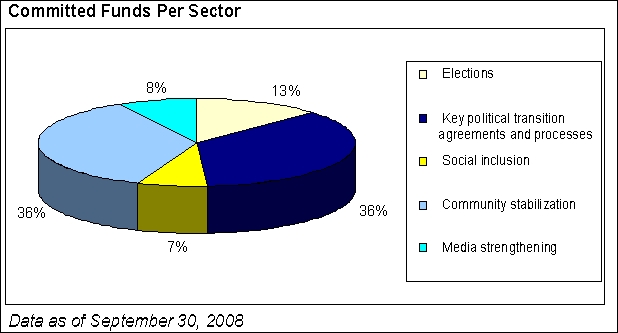  |
  |
 |
|||||||||||||||||||||||||||||||||||||||||
During the reporting period, the Itahari field office cleared 46 grants totaling $1,366,349; the Kathmandu office cleared the remaining grants. More than $5.57 million has been disbursed since program inception. B. Grant ActivityCommunity Stabilization – To specifically address ethnic tensions among youth in the Terai, OTI provided parallel training to 20,000 Madhesi and Pahadi youth peer educators in conflict resolution and community peace building. These individuals have made remarkable contributions in their communities. Through village-level orientations, the youth peer educators became recognized as local peace-building experts and activists and developed the capacity to analyze the youth-, gender-, and caste-based conflicts in their communities and resolve them peacefully. It is widely understood that poor service delivery at the local level contributes to the public’s appetite for political change. With activities grounded in the fundamental principals of development, local ownership, and contribution, OTI has found its local networks to be eager partners in addressing development needs at the community level. OTI’s youth mobilization committees are engaging youth to develop their Village Development Committees (village areas or VDCs) through the use of community development funds (CDFs). The youth committees work with their communities to select, implement, and participate in small-scale development projects that are financed through these funds. Projects have included reconstruction of community libraries and early childhood development centers, rehabilitation of roads and schools (repairing roofs, painting, etc.), and other small-scale efforts. Community response to these CDF-funded activities has been strong, generating impressive contributions of both money and labor. The youth mobilization committees are successfully managing both the process and the communities’ contributions. The activities are demonstrating that young people can play positive and dynamic roles in their communities. The CDF activities are being replicated across the Terai and have been implemented in more than 350 VDCs to date. Cultural activities: Street dramas and other cultural events are a popular mechanism for disseminating messages in Nepal. Two of OTI’s most successful grants funded a traveling exhibition of photographs from “A People War: Images of the Nepal Conflict, 1996-2006,” a book that documents the suffering experienced during Nepal’s 11-year insurgency. The images, most of which were taken by Nepali photographers, have reminded the people of Nepal about the costs of war and motivated them to collaborate on peaceful solutions during the current political transition. More than 300,000 people saw the photo exhibition at 31 locations, and copies of the book were distributed to libraries, schools, and youth clubs across the nation. A 40-minute documentary called “Frames of War,” which focused on the second phase of the exhibition tour, was also produced. In addition, 19 television news stories were produced in conjunction with the documentary. OTI also supported a number of musical and cultural events to encourage communal harmony among the Pahadi and Madhesi communities and increase awareness of the peace process. At two large fairs in the Terai, OTI supported essay contests, art displays, dance performances, quiz shows, and peace stalls. At one fair, more than 20,000 visitors stopped by the peace stall to receive information on the Comprehensive Peace Agreement (CPA). The other fair received more than 42,000 visits to its peace stall. In addition, OTI supported a campaign to enhance the relationship between the Madhesi and Pahadi communities and model positive interethnic cooperation. Through the campaign, 10 Pahadi and 20 Madhesi female artists collaborated to paint, in the Mithila style, 39 murals expressing peace messages. The campaign successfully promoted positive Madhesi-Pahadi relations in four districts of the central Terai and was subsequently replicated in three eastern Terai districts, where 60 additional peace murals were created. Community engagement through media: Throughout the life of its program, OTI has supported the use of media to promote peaceful transition in Nepal. To address the public’s elevated expectations for the new government following the CA election, OTI funded the development and airing of a dozen 60-second television PSAs. Produced by a well-known Nepali comic duo and a group pioneering the use of computer animation (“Toy Story”-style), the PSAs addressed the need for reasonable expectations of government, encouraged political tolerance, and promoted a peaceful and democratic transition in Nepal. OTI also supported radio PSAs promoting communal harmony. These PSAs enlisted candidates and prominent social leaders to record messages of peace to help preempt any rise in communal divisions and related violence before and after the election. The introduction of new and innovative programming concepts has increased public discourse and participation through media. For example, building on the success of a pioneering, OTI-supported national call-in radio show, three local radio stations have begun producing talk shows designed to improve dialogue between district-level government officials and their constituents. Relatively modest equipment grants have allowed the stations to establish toll-free call-in capabilities, giving listeners the ability to raise concerns and address questions to local and national decision makers during live broadcasts. With conceptual assistance from National Public Radio (NPR), OTI partner Antenna Foundation Nepal has launched its multimedia Mero Jindagi (My Life) campaign, which is based on NPR’s “This I Believe” program. It is the first international adaptation of the NPR program, and the campaign will engage Nepali citizens from all walks of life in a discussion of the core values and beliefs that guide their daily lives. Twenty-six television and radio packages will be developed, showcasing citizens who have made positive contributions to their families, communities, regions, and the nation. In conjunction with the broadcasts, the participants’ stories will be published as personal essays in newspapers. The grantee has also commissioned a theme song, “My Life – My Belief,” from a well-known Nepali lyricist. Elections – OTI also established and maintained a fully equipped and functional media center for the EC. The center provided a facility where journalists and media representatives could access official, timely, and accurate information before, during, and after the CA election. The facility accredited approximately 1,200 national and 128 international journalists, hosted 22 press conferences, and provided filing, research, and broadcast support to an average of 300 journalists a day during the election cycle. Using media for voter education and managing expectations: The Nepali people viewed the CA election as a historic event through which they could redress long-held grievances by exercising their right to vote. However, staging the election presented numerous challenges, not the least of which was initiating a new and complicated election system. The Nepali people also expect the CA election to lead to the creation of a new constitution. And in the days and weeks following the election, OTI worked to manage unrealistic expectations and educate the public on legislative procedures and the role and mandate of the CA. OTI developed PSAs that provided election-related information in Nepali and 15 local languages and aired these spots on 19 local FM radio stations around the country. OTI also improved stations’ technical news-gathering capabilities and provided training and logistical support to 69 local journalists to enhance media coverage in the run-up to the election. Additional activities funded civic education campaigns designed to encourage patience in the post-election environment. These activities included printing, translating, and distributing post election information materials. The Nepali version of the EC’s leaflet “What Happens After the Polls Close?” was published in three major national and four regional daily newspapers with a total circulation of 376,000. An additional 60,800 copies of the leaflet were provided to OTI’s local nongovernmental organization (NGO) partners for distribution to the public, and 1,600 were copies distributed via the EC media center, the United Nations Development Programme, and the United Nations Mission in Nepal just before the CA election. OTI’s support to election-related activities effectively educated voters and promoted and facilitated professional, objective, and factual national, local, and international media coverage of the CA election. Recently, OTI has been asked to support a voter education campaign for five by-elections that are expected to take place sometime in November. Key Political Transition Agreements and Processes – Grants to six regional radio stations supported content development for shows focusing on the CPA, the CA election, and transition issues. Structured as call-in and VDC-level dialogues, these programs were interactive and produced in both Nepali and local languages. The programs proved so popular that the activity was extended to include information on the roles and responsibilities of the CA and on helping manage citizen expectations of the new government. Continuing successful media campaigns: OTI’s animated Messengers of Change PSAs, launched in 2007, continue to receive praise throughout the country. In a survey conducted by the BBC World Service Trust and ACNielsen, approximately 50 percent of respondents said they recognized the campaign’s multiethnic, animated characters. New PSAs were aired in this reporting period to convey messages addressing peace and security, diversity and communal harmony, reconstruction, the CPA, and participation in the CA election. In addition, 12 comic strips featuring the characters are being developed. OTI also issued a grant for 15 new episodes of “MaHa Sanchar,” a popular comedy show with content focusing on ongoing transitional issues. This entertaining program has reached a large number of Nepali viewers with information about key political transition processes and agreements in the changing political context. The program’s broadcaster estimates that 7.5 million viewers (more than 80 percent of them in Nepal) watched the new shows regularly – an increase of 2 million in Nepal and 500,000 abroad over earlier shows. The new episodes provided social and political commentary addressing the country’s deteriorating law-and-order situation and its effect on people’s lives, the CA deliberations, and citizen expectations following the election. Street dramas educate and engage communities: OTI believes, and two assessments conducted during the reporting period confirmed, that drama continues to be an excellent mechanism for articulating and reinforcing key transition-process themes. With support from OTI, a grantee staged 345 street dramas in eastern Terai districts. The activity trained and mobilized performers to foster grassroots awareness in three areas: (1) the role of the CA, (2) citizen responsibilities in the constitution writing process, and (3) the debate among elected representatives concerning what the “new Nepal” will look like, with a focus on prompting patience. The grantee consistently received positive feedback and was inundated with requests from officials and citizens to stage shows in their communities. The activity was extended to a number of areas where knowledge of the CA is low and where expectations, as well as security threats, are high. Outreach for the CA: With the overwhelming success of the EC’s media center, which the program supported during the CA election, OTI cleared three successive grants to the Secretariat of the Legislative Parliament of Nepal. The grants will provide equipment and facilities support to develop and launch a media resource center that includes space for journalists, a press conference hall, and an internal system to broadcast CA proceedings. It is anticipated that this activity will establish a permanent public information interface for the assembly. Social Inclusion – In an attempt to address the destabilizing environment in the Terai, OTI undertook a number of activities designed to address the root causes of Madhesi disenchantment and improve Madhesi access to Nepali society. Peace rallies: Prominent artists and civil society leaders attended a series of 1-day peace and harmony rallies in the eastern Terai. Organized by an umbrella organization, a 60-member committee and 140 members of affiliated NGOs traveled to the rally sites from VDCs across the region. Despite strikes that disrupted normal transit, the rallies attracted an average of 6,000 people, and one had more 12,000 attendees. The events received widespread national, regional, and local media coverage. Peace albums: The production and release of a six-song album featuring a collaboration of Maithili musicians and poets was so successful that the grant was amended to include a second eight-song album. The songs, which were sung in Maithili, emphasized communal harmony and peace advocacy. A total of 3,000 cassettes and 1,000 CDs were distributed, and the songs garnered attention from national news and entertainment media outlets. Media Strengthening – OTI’s successes with the dissemination of key transitional messages in 2008 relied on a media infrastructure that the program helped develop during the previous year. In support of a free, energetic, sustainable, and sophisticated media, OTI engaged with partner organizations to advance Nepal’s media sector as a professional and fully functional public institution. Journalist training: OTI is training 28 radio journalists from 14 grassroots FM stations. The activity focuses on issues relating to state restructuring, federalism, and the CA, providing instruction in balanced reporting methods. The primary objective of this activity is to promote two-way communication between rural areas and Kathmandu; however, the project also seeks to broadly advance the professionalism of the stations’ journalists and broadcasters. Various agitating groups in the Terai have targeted local and national media outlets and journalists. Pahadi journalists operating in the Terai are often accused of bias and failure to fairly represent Madhesi people and issues. Stories based on stereotypes and generalizations have triggered violence between the Madhesi and Pahadi communities. In response, OTI funded interethnic exchange visits for 10 Madhesi and 10 Pahadi journalists in sensitive areas of six eastern hill and Terai districts. The journalists produced 60 articles in conjunction with the activity, illuminating communal and political issues, exploring the common as well as the different challenges the communities face, and confronting the myths that prevail in both communities. Following the overwhelming success of the activity, OTI plans to initiate similar journalist exchange visits in western Terai regions. Equipping and expanding radio: In mid-March, Radio Kailash began test transmissions in Humla, a remote and historically marginalized district in the far northwest region of the country, with equipment acquired through OTI support. The station was launched officially on May 26. Radio Kailash broadcasts music; an OTI-supported national, live call-in talk show; national news (through a national satellite communication system also supported by OTI); and local programs to more than 20,000 listeners across the district. During the reporting period, 23 local FM stations requested access to the OTI-supported satellite radio network. To support this expansion, seven back-up receivers were purchased to minimize disruptions from breakdowns and maintenance. This is the second time the network has been expanded. Media code of conduct: With OTI support, a media code of conduct was completed, marking an initial media-sector effort to codify a unified set of guidelines. Initially, media organizations are responsible for self-policing under the code; even so, it should play an important role in moderating inflammatory speech or inappropriate use of the media. C. Indicators of SuccessRe-targeting/Flexibility – The OTI media strategy has consistently supported information dissemination networks that display flexibility in response to the ongoing transition. OTI has supported radio and television shows that address current transitional issues through innovative programming, including call-in radio shows at the national and local level, animated PSAs, and the MaHa series of television shows. While these three activities are supported through standing grants, the grantees have proven highly responsive and ready to take on rapidly evolving transition issues. The same types of arrangements are now under development with regional and local media, especially radio stations. OTI has had significant success addressing the immediate and critical information dissemination demands of the transition process through radio and television PSAs and through the targeted purchasing of newspaper advertising and supplements. When the CA elections were postponed, several activities focused on the CA were refocused to address other transitional issues, including raising awareness of the CPA. After the election, activities were quickly shifted to efforts to manage post-election expectations. In these adjustments, OTI’s partners have been very responsive, and the program’s use of its established communications vehicles has meant that critical information gets out quickly and is well received. Speed – OTI was able to respond rapidly to a number of requests. This speed was noticed by Nepali institutional counterparts.
Indicators of Impact – In January 2008, OTI began community development fund (CDF) activities in five districts. These activities have had a symbolic as well as a tangible effect on the communities and youth involved in them. With the state and, consequently, government services largely absent in many areas, the CDF activities were more than likely the first publicly initiated projects in these communities for some time. Furthermore, some of the youth mobilization committees established under the CDF activity have gone on to manage additional projects in their communities. OTI has also observed a marked increase in the self-confidence of the youth peace volunteers trained through the program, as their responsibilities within their communities have expanded. In turn, the communities have turned to the volunteers to moderate and mitigate local conflicts. Increasingly, the youth volunteers are reporting that the nominal stipends they receive are less important than the esteem they derive from fostering civic engagement and generating a moral voice in their communities.
Media activities in the OTI program portfolio have focused primarily on increasing information access and diversifying public debate on issues critical to the political transition. These activities achieved many initial successes (a national call-in program, Doko radio, the MaHa television shows, and Messengers of Change PSAs), have been expanded, and are inspiring imitations by national and local media outlets. The infusion of targeted and conditional funding has pushed regional and local FM radio stations to develop better programming. The funding has also helped station managers recognize that, in addition to providing entertainment, they can serve the public good and garner larger audiences as conduits of information and outlets for professional journalism. By design, but also increasingly without overt pressure or funding, these interactive programs are addressing OTI’s second objective – to increase local-level engagement and participation in the peace process. Next Steps/Immediate PrioritiesEmergent issues include:
USAID/OTI Nepal will –
For further information, please contact:
| |
||||||||||||||||||||||||||||||||||||||||||
| |||||||
| |||||||
